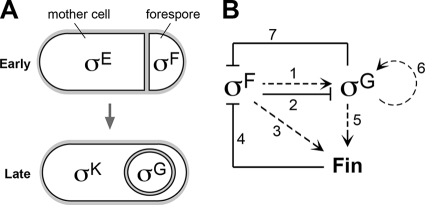FIG. 1.
A role for Fin (YabK) in sigma factor switching during sporulation in B. subtilis. (A) Cartoon depicting the sigma factors directing compartment-specific gene expression in sporangia at early (top) and late (bottom) stages of development. At early times, the sigma factors σF and σE direct gene expression in the forespore and mother cell, respectively. At later times, after the forespore is engulfed by the mother cell, σF is replaced by σG and σE is replaced by σK. (B) Model for the switch from σF to σG. To begin, σF activates transcription of the gene (sigG) for σG (arrow 1); however, σG activation is delayed through poorly understood mechanisms that likely involve σF (barred line 2) (see Discussion). To trigger the switch to σG, σF also directs synthesis of its own inhibitor, Fin (arrow 3). Once σF is inactivated by Fin (barred line 4), σG becomes active. This transition is reinforced by two mechanisms. First, σG continues to direct fin synthesis, resulting in sustained σF inhibition (arrow 5). Second, σG autoregulates its own gene, leading to large amounts of the late sigma factor (arrow 6). σG also inhibits σF by an unknown, Fin-independent pathway (barred line 7) (see Discussion). In the absence of Fin, unchecked σF activity prevents σG activation, likely due to the same mechanisms represented by barred line 2. Dashed arrows indicate transcriptional regulation. Lines with barred ends indicate inhibition by currently unknown mechanisms.

